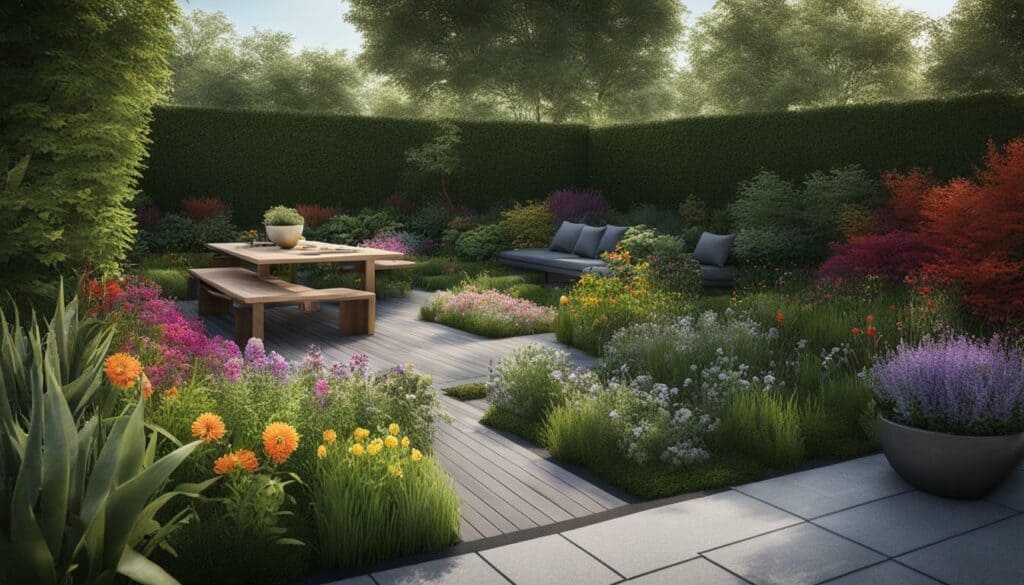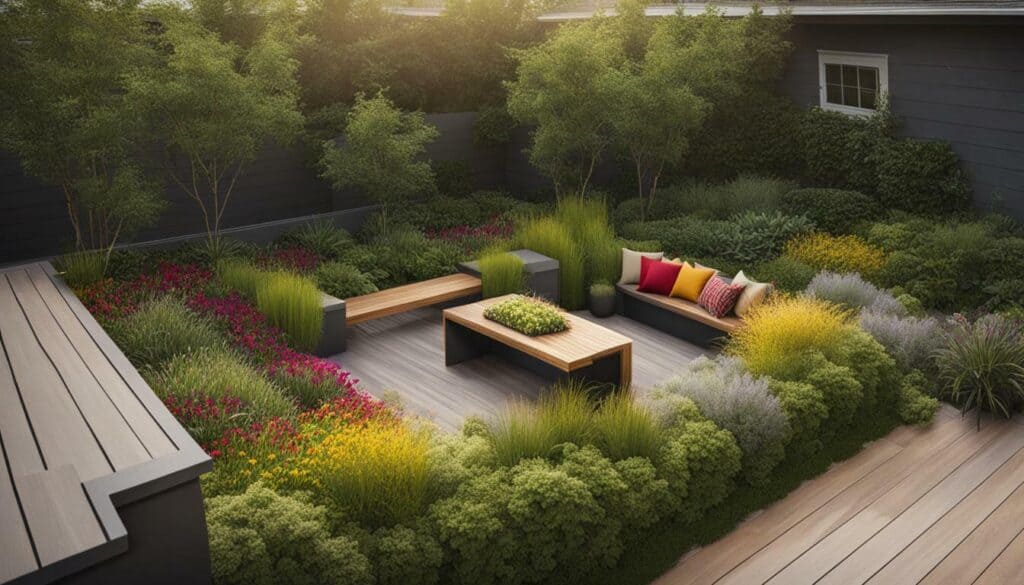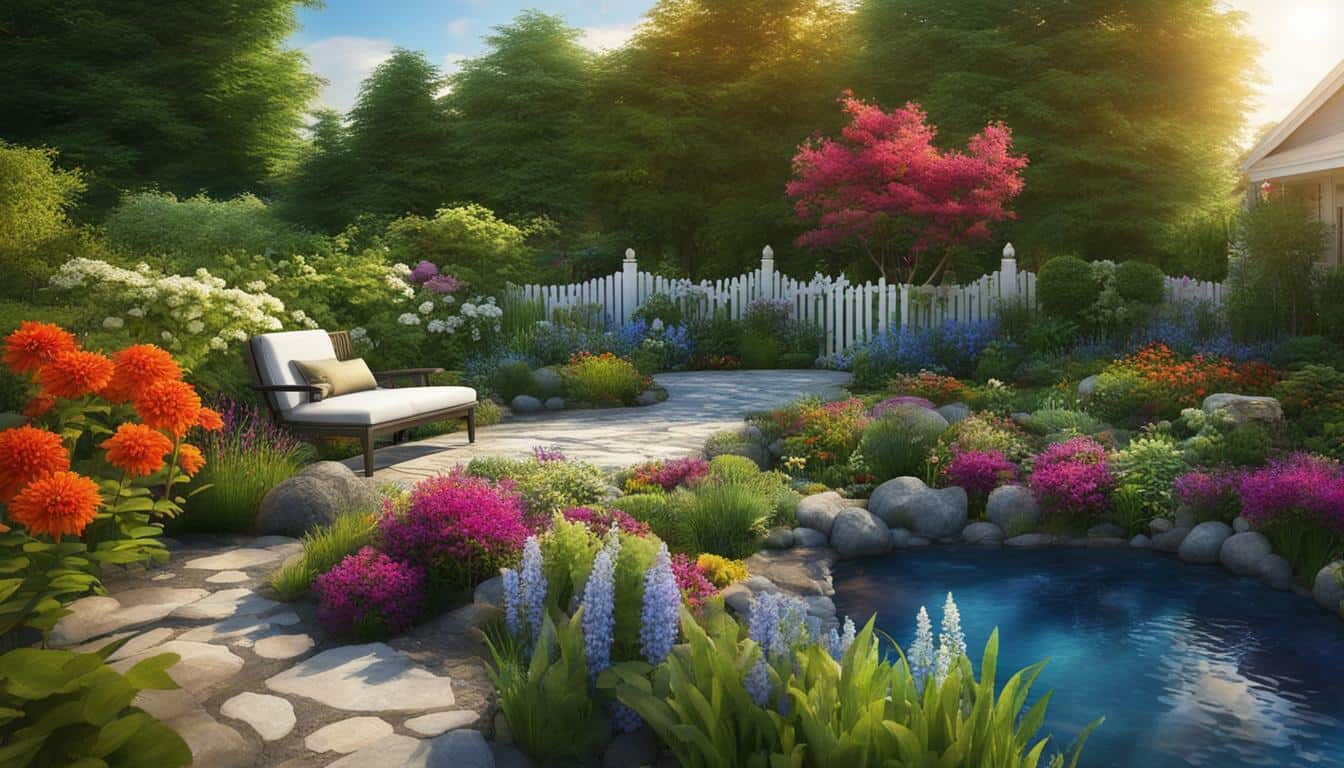Are you a beginner looking to transform your outdoor space into a beautiful garden? Look no further, because with these easy garden design tips, you’ll be able to create a lush and inviting backyard in no time!
If you’re new to gardening, don’t worry! It’s easier than you think to create a stunning outdoor space. With a few simple updates, you can turn your patio or garden into a beautiful oasis that you can enjoy all year round.
Before diving into the more decorative ideas, start by tidying up your outdoor space. Trim back any overgrowth, neaten your beds and borders, and clean your patio or fence. Simple DIY tasks like cleaning a concrete patio or painting a fence can have a big impact on your space.
Key Takeaways:
- Transforming your outdoor space is easy and affordable with these garden design tips.
- Start by tidying up your outdoor space to create a clean slate.
- Consider easy and affordable updates like bringing indoor furniture outdoors or adding a firepit.
- When designing your garden, consider scale, color, and plant groupings.
- Transform your outdoor space with planning, purpose, and creativity!
The Importance of Plants in Garden Design
According to garden designer Joel Bird, plants are the heart and soul of any garden design, offering a multitude of benefits for beginner gardeners. They add color, texture, and fragrance, create natural borders and boundaries, and provide shade and privacy. Plants help to create a welcoming and relaxing outdoor space, and they are essential for attracting wildlife such as birds and butterflies.
When planning a garden, it’s important to choose plants that are suitable for the climate and soil conditions. Beginner gardeners should start with easy-to-grow plants such as herbs, succulents, and low-maintenance perennials. These plants require less watering and care, making them ideal for those who are new to gardening.
In addition to plants, other elements such as seating, lighting, and outdoor structures can enhance the overall design of the garden. A well-designed garden should also consider the style of the house and create outdoor rooms that are functional and aesthetically pleasing. Key design principles such as scale, color, and plant groupings should be followed to create a cohesive and visually appealing garden.
The design should also take into account the intended use of the garden, whether it’s for relaxation, entertainment, gardening, or attracting wildlife. Ultimately, plants play a crucial role in garden design, adding beauty, diversity, and ecological benefits to outdoor spaces.

For beginner gardeners, it’s important to remember that gardening is a process of experimentation and discovery. It takes time to learn about different plants and their needs, and trial and error is part of the process. With patience and perseverance, anyone can create a beautiful and functional garden that provides enjoyment and relaxation for years to come.
Preparing Your Outdoor Space
Before you get started with the fun part of garden design, it’s essential to give your outdoor space a thorough cleanup and preparation. This includes trimming back green overgrowth, raking up leaves and debris, and neatening your beds and borders. Simple DIY tasks like cleaning a concrete patio or painting a fence can also have a huge impact. Once your outdoor space is tidied up, you can move on to the transformational stage.
If you’re a beginner gardener or starting a garden for the first time, it’s important to plan and prepare your outdoor space properly. This means addressing any drainage issues, deciding on a color scheme, and taking into account the natural conditions of your outdoor space such as sunlight and wind. Always start by testing the soil’s pH and amending it if necessary. You’ll want to add any nutrients, organic matter, or soil conditioners that are appropriate for the particular plants you intend to grow. By doing so, you’ll be preparing your soil to maximize plant growth and ensure a healthy garden.
Affordable Updates for Your Outdoor Space
Looking to make a big impact on a small budget? Check out these affordable and simple updates that will instantly transform your outdoor space. Planning is key to making the most out of the space and budget you have when undertaking your garden design for beginners.
One suggestion is to bring indoor furniture outdoors, creating an extension of your home’s interior. You can use your old armchair, a side table or a rug to give your garden a homely feel. Another idea is to make a feature of your potting table by decorating it with garden-related items. Adding a simple sail-like canopy can provide inexpensive shade for a compact patio garden. You could also add a firepit for creating a focal point and adding warmth to the outdoor space.
An affordable lounger can also be a great addition for relaxing in the garden. You can choose from either a classic recliner chair or a modern, more streamlined version. Make sure to accessorize your lounger with a soft cushion and a throw for optimal comfort.
When it comes to design, considering the overall style, scale, color, and plant groupings of your garden can help create a cohesive and enjoyable outdoor space. Why not try experimenting with different textures and patterns to create a unique and interesting garden? Whether it’s redesigning your lawn, planning your planting, or incorporating trees into your landscape, there are various ways to update your outdoor space on a budget.

According to experts, “Affordable garden design doesn’t have to mean compromising on style or quality. By following these simple tips, you can create a stunning outdoor space that will bring joy for years to come.
Designing Your Garden: Style and Principles
When it comes to designing your garden, it’s crucial to think about the style that complements your home and the principles that will guide your choices. According to experts, planning is key to making the most out of the space and budget available.
Gardening is an essential aspect of a garden makeover, as plants provide cover, shade, color, texture, and space for nature. Incorporating a garden style that complements your home is crucial, whether it’s minimalist, English garden, or urban garden. Creating outdoor rooms with defined areas for relaxation, privacy, and shade is also key.
When it comes to choosing plants, focusing on scale, color, and plant groupings can help create a harmonious garden design. Proper lawn care and maintenance, such as mowing and aeration, are essential for a healthy lawn.
| Tip: | Include trees in your garden design. They can provide shade, screen unattractive views, and benefit nature. Multi-stem trees are a popular trend, creating architectural focal points in the garden. |
|---|
To create a cohesive and visually pleasing effect when planting, consider incorporating structural plants and filling gaps with flowering plants. It’s important to design the garden with its purpose in mind, considering factors such as relaxation, entertainment, accessibility, and attracting wildlife.
“A garden is a thing of beauty and a job forever.” – Richard Briers
Designing your garden with style and principles in mind can transform your outdoor space into a beautiful and functional area. Proper planning and consideration of plant selection can help create a cohesive and visually pleasing design. Remember to always keep the intended purpose of your garden in mind when making choices, and don’t forget to enjoy the process and the end result!

Planning Your Garden with Purpose
Before you start digging and planting, take some time to envision how you want to use your garden and the elements that will make it truly special. Assess your outdoor space and determine what needs attention or trimming back. Once you have a clear idea of your garden’s purpose, you can begin to design it with intention.
Consider the style of your home and choose a garden style that complements it. You can create outdoor rooms with defined areas, such as a seating area or a kitchen space, to make your garden more functional. Pay attention to scale, color, and plant groupings to create a cohesive and visually appealing design.
When it comes to planting, start with structural plants like evergreen shrubs and fill in the gaps with flowering plants. Choose plants that complement each other and create a harmonious color palette. Consider the height and width of plants, as well as their water needs, when arranging them in your garden.
Trees can be a focal point in your garden and provide shade and shelter for wildlife. Multi-stem trees are a popular choice for creating architectural interest and can be underplanted or left to make a statement on their own.
Planning your garden with purpose and considering these design principles will ensure that you create a beautiful and functional outdoor space that you’ll love for years to come. Beginner-friendly garden design and garden design for beginners can be achieved by following these simple steps.

“By failing to prepare, you are preparing to fail.” – Benjamin Franklin
Planting for Visual Appeal
Plants are the stars of any garden, and with these tips, you’ll be able to create visual appeal and a harmonious balance in your outdoor space. When choosing plants, consider their size, shape, and color, and select those that complement the style of your home. A well-placed container garden can provide height and color, while climbing plants can add interest to walls and fences.
Incorporating structural plants, such as evergreens and topiaries, can provide year-round interest and create a sense of order in your garden. Repeating patterns and colors can also create a cohesive look. Planting in clusters or in rows can highlight specific areas of your garden, and creating different sections with different color schemes can add interest and variety.
Adding trees to your garden can provide shade, privacy, and architectural interest. Mature trees can add value and beauty to your outdoor space. Choose trees that are suited to your climate and the size of your garden.
Don’t be afraid to experiment with different plant combinations and arrangements. By considering the style and function of your garden, planning the layout with structural plants and flowering plants, and incorporating trees for shade and architectural interest, you can create a garden that is not only beautiful but functional and enjoyable as well.

By incorporating a few budget-friendly ideas, such as using indoor furniture outdoors, creating a feature wall above a potting table, and adding instant shade with a sail-like canopy, you can transform your outdoor space into a stunning and inviting area. Remember to choose plants that complement your home’s style and create a color palette for each section of your garden to create a cohesive and harmonious look.
Creating a Sustainable Garden
In addition to creating a beautiful garden, you can also make it environmentally friendly and sustainable by incorporating these practices into your design. Creating a sustainable garden involves making conscious choices to minimize waste, conserve water, and promote biodiversity. Budget garden ideas can prioritize functionality and eco-friendly practices. Before designing a garden, planning is key to maximize the space and budget available.
Gardening not only helps transform the outdoor space but also provides cover, shade, and space for nature. Tidying up the garden, hoeing borders, and applying mulch or manure are essential steps to preparing for the new season. There are plenty of easy and affordable updates that can transform the appearance of an outdoor space. For instance, bringing indoor furniture outside, creating a feature wall above a potting table, adding shade with a simple sail-like canopy, incorporating firepits for warmth and ambiance, and snapping up affordable garden furniture are some of the simple ideas that can create a sustainable outdoor space.
When designing a garden, it is important to choose a style that complements the house and to create outdoor rooms that serve specific functions. Scale, color, and plant groupings are key principles to consider. The mature size of plants should be considered to avoid overcrowding. Creating a color palette and planting in drifts can create a cohesive and visually appealing garden design.
Before designing a garden, consider how the space will be used and who will use it. Additionally, incorporating trees into the design provides numerous benefits, including shade, privacy, noise reduction, wildlife habitat, and air purification. Creating a sustainable garden is about making conscious choices that promote environmental stewardship and enhance the beauty and functionality of outdoor spaces.
Overall, creating a sustainable garden involves incorporating eco-friendly practices and budget garden ideas. Planning and designing a garden with a purpose not only enhances the outdoor space but also provides cover, shade, and space for nature. When designing a garden, it’s crucial to make conscious choices that promote environmental stewardship and enhance the beauty and functionality of outdoor spaces.
Conclusion
With careful planning, attention to design principles, and a touch of creativity, beginners can easily transform their outdoor spaces into stunning gardens. As you begin your garden design journey, consider the style and theme of your garden to ensure it complements the style of your home. Creating outdoor rooms can add functionality and aesthetics to your garden, providing spaces for relaxation, entertainment, and privacy.
Remember to keep scale, color, and plant groupings in mind as you plan your garden design. These essential design principles can greatly impact the overall look and feel of your garden. When considering plant selection and placement, think about how you want to use the space and who will be using it. Structural plants, a mix of evergreens and flowering plants, and mature trees can all contribute to a beautiful and sustainable garden design.
Overall, garden design for beginners can be an easy and rewarding process. Whether you are seeking an outdoor oasis or a simple but elegant space, incorporating the right elements and principles can help you achieve your goals. By following these tips and using your own creativity, you can transform your outdoor space into a beautiful and functional garden.
What Are Some Tips for Using a Stone Basin Garden in a Beginner’s Garden Design?
Incorporating a stone basin garden is an excellent way to enhance outdoor space with stone basin. For beginners, start by selecting a suitable location, ensuring proper drainage, and choosing the right stone basin that complements the garden design. Adding water plants, such as water lilies or lotuses, can add beauty while attracting wildlife. Additionally, surrounding the stone basin with potted plants or decorative stones can further enhance its visual appeal.
FAQ
Q: What are some easy and affordable updates for my outdoor space?
A: Consider bringing indoor furniture outdoors, making a feature of your potting table, creating shade with a sail-like canopy, adding light and warmth with a firepit, getting an affordable lounger, and carving out a space for an outdoor kitchen.
Q: How should I design my garden?
A: When designing your garden, consider the style that complements your home and how you want to use the space. Design principles to focus on include scale, color, and plant groupings. Pay attention to the scale of plants, create a color palette of 1-3 colors, and mimic nature by planting in drifts.
Q: What should I consider when planning my garden?
A: Before starting your garden design, visualize how you want to use your garden and who will use it. Consider adding features like seating areas, raised beds, privacy screens, or spaces to enhance views. Capture views, if you have them, and prioritize the three design elements that are most important to you.
Q: How should I approach planting in my garden?
A: Start with structural plants and fill in with pretty flowering plants. Use evergreen shrubs for the frame and choose a few types of plants in repeated patterns. Consider using containers for flexibility and include climbers for height. Add out-of-season performers or spring and early summer bulbs for year-round color.
Q: How can I create a sustainable garden?
A: Consider using drought-tolerant plants and permeable surfaces. Mature trees can provide shade, screen views, and benefit nature. Multi-stem trees can create an architectural showpiece in your garden.
Source Links
- https://simplysmartgardening.com/garden-design-how-to/
- https://www.housebeautiful.com/uk/garden/designs/a495/garden-design-ideas/
- https://www.idealhome.co.uk/garden/garden-ideas/budget-garden-ideas-197528
- https://www.bhg.com/gardening/landscaping-projects/landscape-basics/landscape-design-for-beginners/
- https://www.idealhome.co.uk/garden/garden-ideas/easy-garden-ideas-202397
- https://www.gardeners.com/how-to/garden-design-basics/5165.html
- https://www.houseandgarden.co.uk/gallery/designing-a-garden
- https://www.gardeningetc.com/advice/how-to-plan-your-garden-design
- https://www.housebeautiful.com/uk/garden/designs/g28/garden-ideas-on-a-budget/
- https://www.bhg.com/home-improvement/porch/outdoor-rooms/cheap-backyard-ideas/
- https://www.gardeningetc.com/design/budget-garden-ideas
- https://www.prettypurpledoor.com/garden-design-principles/
- https://www.countryliving.com/gardening/garden-ideas/g746/garden-plans/
- https://www.realhomes.com/advice/garden-design
- https://www.homesandgardens.com/advice/how-to-plan-a-garden
- https://www.thespruce.com/landscape-design-for-beginners-2130815
- https://www.bhg.com/gardening/design/styles/planning-your-front-yard-landscape/
- https://originalhomesteading.com/grow-a-sustainable-garden/
- https://www.bhg.com/gardening/yard/lawn-care/10-tips-for-sustainable-gardening/
- https://themicrogardener.com/7-sustainable-garden-design-tips/
- https://www.almanac.com/landscape-design-ideas-and-advice-beginners





Leave a Reply